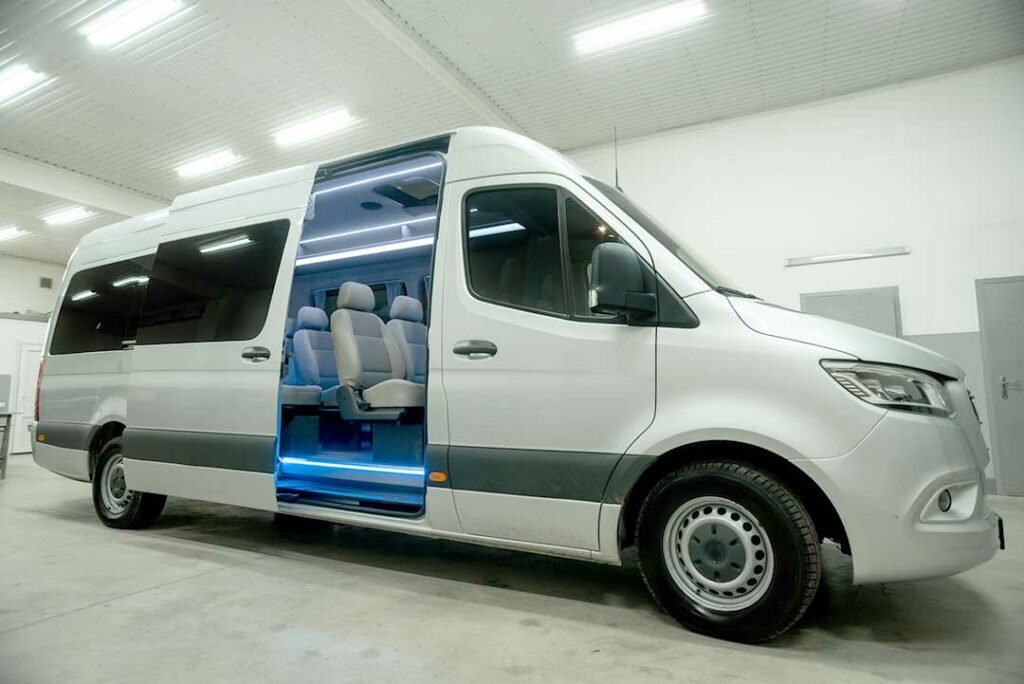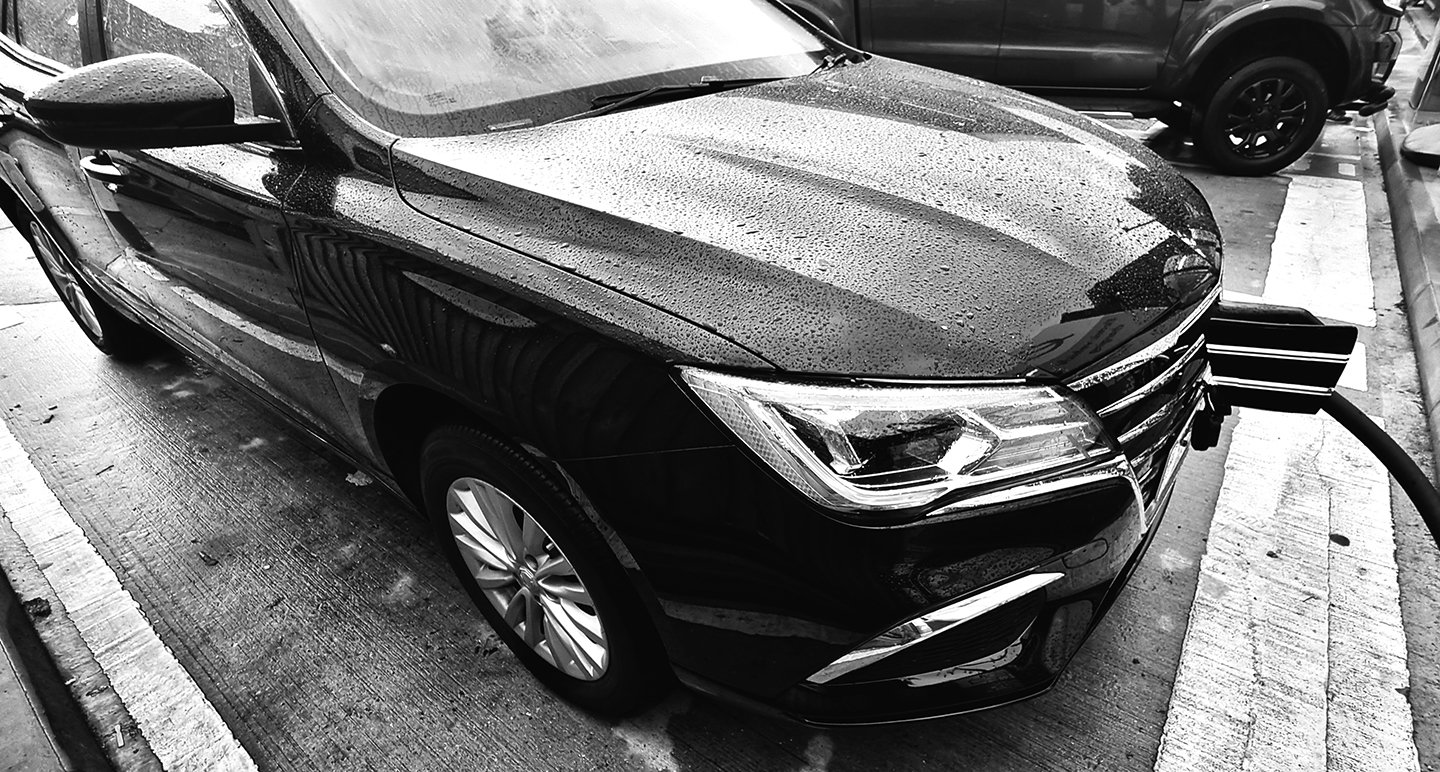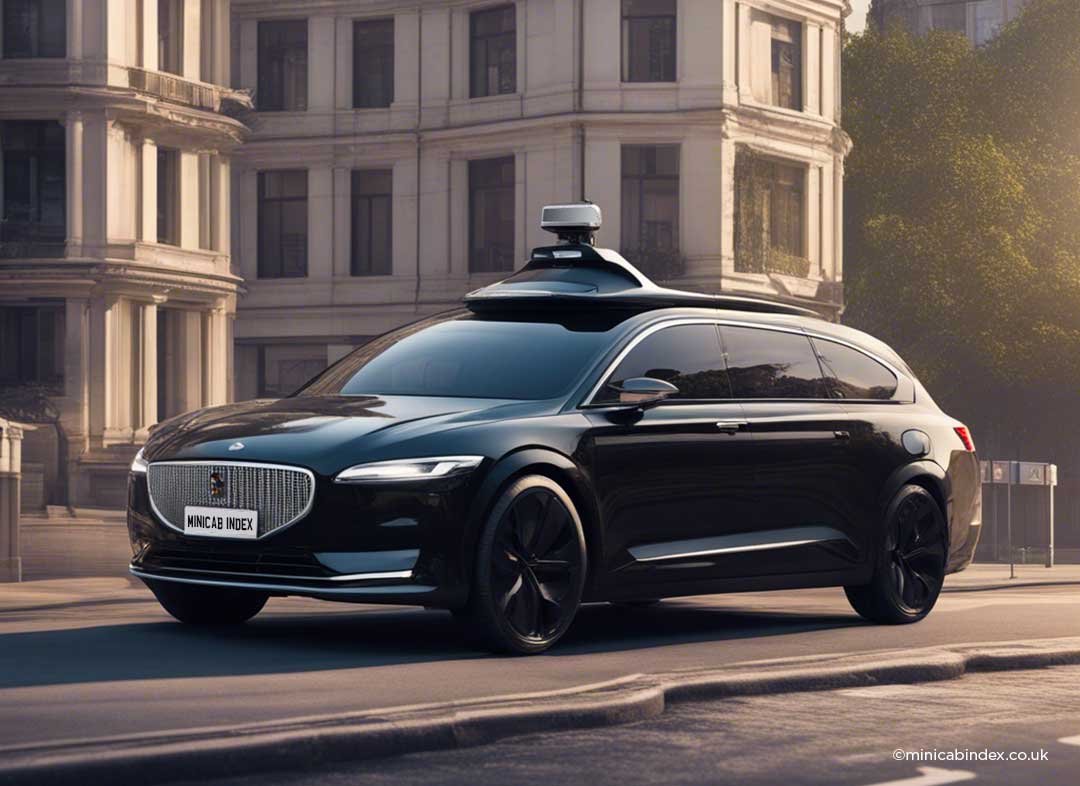Minibus Taxi – Minibuses have become increasingly popular in the taxi and private hire industry due to their versatility and ability to transport more passengers than traditional taxis.
In 2024, there are several types of minibuses available for taxi and private hire services, each with its own unique features and benefits.
Understanding the basics of minibuses is essential for anyone looking to invest in this type of vehicle for their business. Minibuses are typically designed to transport between 8 to 16 passengers and are larger than traditional taxis.
They come in various shapes and sizes, from the compact and fuel-efficient Ford Transit to the spacious and luxurious Mercedes Sprinter.
When it comes to choosing the right minibus for a taxi or private hire service, it’s important to consider the specific needs of the business.
Some minibuses are designed for short city trips, while others are better suited for longer journeys. Additionally, regulations and standards for minibuses in the taxi and private hire industry may vary depending on the location and type of service.
By understanding the different types of minibuses available, businesses can make an informed decision on which vehicle to invest in.
Key Takeaways
Minibus Taxi Types for Taxi and Private Hire in 2024: Updates and Insights
The rumble of diesel engines fades into the hum of electric revolution. Minibus taxis in 2024 are shedding their fossil-fueled past, embracing eco-friendly e-mobility and a kaleidoscope of technological upgrades.
Accessibility takes centre stage, with low-floor designs and integrated assistive features opening doors wider than ever. Buckle up for seamless smartphone bookings, onboard Wi-Fi hotspots, and infotainment systems transforming your journey into a connected haven.
Prepare to be surprised, as innovation redefines the very essence of minibus travel in this electrifying year. Below are a few updated points about Minibus Taxi Types in 2024.
Understanding Minibus Basics
Minibus Definition
A minibus is a type of vehicle that can carry between 8 and 16 passengers. It is commonly used for group transportation, such as airport transfers, school trips, and private hire services. Minibuses are smaller than coaches and are often more cost-effective for smaller groups.
In the UK, minibuses are classified as passenger vehicles and are subject to specific regulations. Drivers must have a valid PCV (Passenger Carrying Vehicle) licence to operate a minibus with more than 8 passengers. Minibuses with 8 or fewer passenger seats can be driven on a standard car licence, as long as the driver meets certain conditions.
Minibus Features
Minibuses come in a range of sizes and configurations, with different features and amenities depending on the model and purpose. Some common features of minibuses include:
Overall, minibuses offer a convenient and cost-effective way to transport small groups of passengers. Whether for business or leisure, minibuses can provide a comfortable and efficient transportation solution.
Minibus Types for Minibus Taxi Services
When it comes to taxi services, minibuses are a popular choice for larger groups of people who want to travel together. There are different types of minibuses available, each with their own features and benefits.
Standard Minibuses
Standard minibuses are the most common type of minibus used for taxi services. They typically have a seating capacity of 8-16 passengers and are ideal for short to medium distance journeys. They are also a cost-effective option for groups who want to travel together.
These minibuses usually come with basic features such as air conditioning, comfortable seating, and a sound system. Some standard minibuses may also have a luggage compartment for storing bags and suitcases.
Luxury Minibuses
Luxury minibuses are a step up from standard minibuses and offer more comfort and luxury. They are ideal for longer journeys or for groups who want to travel in style.
These minibuses typically have a seating capacity of 8-16 passengers and come with additional features such as leather seats, air conditioning, and a DVD player. Some luxury minibuses may also have a mini-fridge and a toilet.
Luxury minibuses are more expensive than standard minibuses but are worth the extra cost for those who want a more comfortable and luxurious travel experience.
Accessible Minibuses
Accessible minibuses are designed for passengers with disabilities and are equipped with features such as wheelchair ramps and lifts. These minibuses are ideal for taxi services that cater to passengers with disabilities.
Accessible minibuses typically have a seating capacity of 8-16 passengers and come with basic features such as air conditioning and comfortable seating. Some accessible minibuses may also have a sound system and a luggage compartment.
Overall, there are different types of minibuses available for taxi services, each with their own features and benefits. Whether you choose a standard minibus, luxury minibus or accessible minibus, you can be sure to find a minibus that meets your needs and budget.
Minibus Types for Private Hire
Private hire companies often use minibuses to transport groups of people to and from their destinations. There are several types of minibuses available for private hire, each with their own features and benefits.
In this section, we will discuss two types of minibuses that are commonly used for private hire: executive minibuses and coach-built minibuses.
Executive Minibuses
Executive minibuses are luxurious and comfortable vehicles that are ideal for corporate events, weddings, and other special occasions. These minibuses are equipped with high-end features such as air conditioning, leather seats, and entertainment systems. They typically have a seating capacity of between 8 and 16 passengers.

Executive minibuses are perfect for businesses that want to transport their employees or clients in style. They are also a popular choice for weddings and other formal events. These minibuses are typically more expensive than other types of minibuses, but they offer a premium experience that is worth the extra cost.
Coach Built Minibuses
Coach-built minibuses are larger vehicles that are designed to transport larger groups of people. They typically have a seating capacity of between 16 and 32 passengers. These minibuses are ideal for school trips, sports teams, and other large groups.

Image Credit: flexerent.co.uk
Coach-built minibuses are often equipped with features such as air conditioning, reclining seats, and luggage storage. They are also designed with safety in mind, with features such as seat belts and emergency exits.
Overall, there are several types of minibuses available for private hire, each with their own unique features and benefits. Private hire companies should choose the type of minibus that best suits their needs and the needs of their customers.
Regulations and Standards in 2023
The minibus regulations and standards in the UK in 2023 are set out in the following legislation:
- The Road Vehicles (Construction and Use) Regulations 1986
- The Road Vehicles (Testing and Maintenance) Regulations 1981
- The Public Service Vehicles (Conditions of Fitness, Equipment, Use and Certification) Regulations 2001
- The Public Service Vehicles Accessibility Regulations 2000
These regulations cover a wide range of topics, including the design, construction, and maintenance of minibuses, as well as the qualifications and training of minibus drivers.
Some of the key regulations and standards that apply to minibuses in the UK include:
- Minibuses must have a valid MOT certificate.
- Minibuses must be maintained in a good and roadworthy condition.
- Minibus drivers must have a valid driving licence and must have completed the relevant driver training.
- Minibuses must be fitted with certain safety features, such as seat belts, speed limiters, and tachographs.
- Minibuses must be accessible to passengers with disabilities.
In addition to the above regulations, there are also a number of voluntary standards that minibus operators may choose to follow. These standards are designed to improve the safety and quality of minibus services.
For example, the Confederation of Passenger Transport (CPT) has developed a set of voluntary standards for minibus operators. These standards cover a wide range of topics, including vehicle maintenance, driver training, and customer service.
Minibus operators who choose to follow the CPT standards can apply for a CPT accreditation. This accreditation demonstrates to customers that the operator is committed to providing a high-quality service.
If you are considering hiring a minibus, it is important to check that the minibus operator is following all of the relevant regulations and standards. You can do this by asking the operator for a copy of their MOT certificate and their CPT accreditation certificate.
Safety Regulations
In 2023, taxi and private hire vehicle (PHV) operators in the UK will need to comply with new safety regulations. The Taxis and Private Hire Vehicles (Safeguarding and Road Safety) Act 2023 will introduce a range of measures to improve passenger safety, including:
- A requirement for all new PHVs to be fitted with CCTV cameras
- Enhanced background checks for drivers
- A new national licensing database to ensure that licensing authorities can share information about drivers and vehicles more easily
The government has also issued new statutory taxi and PHV standards to licensing authorities. These standards cover a range of areas, including:
- Vehicle maintenance and safety checks
- Driver conduct and training
- Passenger safety and comfort
Emission Standards
From 1 January 2023, all PHVs licensed for the first time must be zero-emission capable (ZEC) and meet the Euro 6 emissions standard. This means that they must emit no more than 50mg/km of nitrogen oxides (NOx) and no more than 0.005g/km of particulate matter (PM).
PHVs that are already licensed by Transport for London (TfL) must be no older than 10 years from the date of their first registration. PHVs that are licensed outside of London must comply with the relevant local authority’s licensing requirements.
Operators who fail to comply with these emission standards may face fines or have their licenses suspended or revoked. However, the government has announced a range of financial incentives to help operators make the switch to zero-emission vehicles, including grants for new vehicles and charging infrastructure.
Overall, these new regulations and standards are designed to improve the safety and environmental performance of the UK’s taxi and PHV sector. While they may present some challenges for operators, they are ultimately aimed at ensuring that passengers can travel safely and sustainably.
Minibus regulations and guidance
The most relevant page is the Minibus regulations and guidance: Driving a Minibus page. This page provides information on the following topics:
- Who needs a minibus permit
- How to apply for a minibus permit
- Minibus vehicle standards
- Minibus driver standards
- Operating a minibus
The page also includes links to a number of other relevant documents, such as the Public Service Vehicles (Conditions of Fitness, Equipment, Use and Certification) Regulations 2001 and the Public Service Vehicles Accessibility Regulations 2000.
If you have any specific questions about minibus regulation, you can contact the Driver and Vehicle Licensing Agency (DVLA) or the Department for Transport (DfT).
Here are some additional resources that you may find helpful:
- Confederation of Passenger Transport (CPT)
- National Association of Passenger Transport (NAPT)
- Minibus Hire Association (MHA)
These organisations provide a range of resources and support to minibus operators and minibus taxi including information on the latest regulations and guidance.
Choosing the Right Minibus
When it comes to choosing the right minibus for taxi and private hire services, there are a few important considerations to keep in mind. Here are some key factors to think about when selecting a minibus for your business:
Considerations for Taxi Services
For taxi services, it’s important to choose a minibus that can comfortably accommodate a range of passengers. Look for a vehicle with enough seating capacity to transport larger groups, but also consider the overall size of the minibus. It’s important to choose a vehicle that is easy to manoeuvre and park in urban areas, where space can be limited.
In addition to seating capacity and size, taxi services should also consider the following factors:
Considerations for Private Hire
For private hire services, the focus should be on providing a comfortable and luxurious experience for passengers. Look for a minibus with premium features and amenities, such as leather seats, climate control, and entertainment systems.
In addition to luxury features, private hire services should also consider the following factors:
By carefully considering these factors, taxi and private hire services can choose the right minibus to meet their specific needs and provide a comfortable and safe experience for their passengers.
Conclusion
In conclusion, there are various types of minibuses available for taxi and private hire services in 2023. The choice of minibus will depend on the specific needs of the passengers, the distance of the journey, and the budget of the customer.
For short trips with a small group of passengers, a standard minibus with a capacity of 8-16 seats will suffice. These minibuses are cost-effective and provide comfortable seating for passengers. They are ideal for airport transfers, corporate events, and short trips around town.
For longer journeys and larger groups of passengers, a luxury minibus with a capacity of 16-24 seats may be a better option. These minibuses are equipped with air conditioning, reclining seats, and entertainment systems to provide a comfortable and enjoyable ride for passengers. They are ideal for longer trips, such as school trips, sports events, and weddings.
For passengers with disabilities, a wheelchair accessible minibus is the best option. These minibuses are equipped with ramps, lifts, and other accessibility features to provide easy access for passengers with disabilities. They are ideal for transporting passengers to medical appointments, social events, and other activities.
Overall, the choice of minibus will depend on the specific needs of the passengers. It is important to choose a reputable and reliable minibus hire company that can provide a safe and comfortable ride for passengers. Click here to find out average minibus hire cost for taxi and private hire service.
FAQ
What are the TfL vehicle requirements for private hire minibuses in 2023?
Transport for London (TfL) has specific vehicle requirements for private hire minibuses. In 2023, a private hire minibus must have a minimum of 9 seats and a maximum of 16 seats. The vehicle must also comply with the Ultra Low Emission Zone (ULEZ) standards. The driver must have a PCO minibus license and the vehicle must be licensed as a private hire vehicle (PHV) with TfL. (Please check TfL Website for Instant updates)
What is the list of ZEC vehicles approved for private hire in 2023?
In 2023, TfL has approved a list of Zero Emission Capable (ZEC) vehicles for private hire use. The list includes models from manufacturers such as Nissan, Renault, and Tesla. Private hire operators can choose from a range of ZEC vehicles to meet the new ULEZ emissions standards.
What are the new rules for private hire vehicles in 2023?
In 2023, TfL has introduced new rules for private hire vehicles. These include mandatory CCTV in all PHVs, mandatory driver training, and new safety requirements for child seats. Private hire operators must also ensure that their drivers are licensed and have passed a criminal record check.
What are the requirements for a PCO minibus in the UK in 2023?
In 2023, a PCO minibus in the UK must meet the same vehicle requirements as a standard PHV. The vehicle must be licensed with TfL as a PHV and must comply with the ULEZ emissions standards. The driver must have a valid PCO minibus license and must pass a criminal record check.
What is the minimum fare that a private hire vehicle can charge for a journey in 2023?
In 2023, TfL has set a minimum fare for private hire vehicles. The minimum fare for a PHV journey is £3.00. This is to ensure that drivers are not underpaid for short journeys and to provide a fairer pricing structure for passengers.
What is the minimum fare that a private hire vehicle can charge for a journey in 2023?
In 2023, TfL has set a minimum fare for private hire vehicles. The minimum fare for a PHV journey is £3.00. This is to ensure that drivers are not underpaid for short journeys and to provide a fairer pricing structure for passengers.
What is a PHV and how does it differ from a taxi in 2023?
A PHV is a private hire vehicle that can only be booked in advance through a licensed operator. In 2023, PHVs must comply with specific vehicle and driver requirements set by TfL. Taxis, on the other hand, can be hailed on the street and can use taxi ranks. Taxis also have different vehicle and driver requirements set by TfL.






